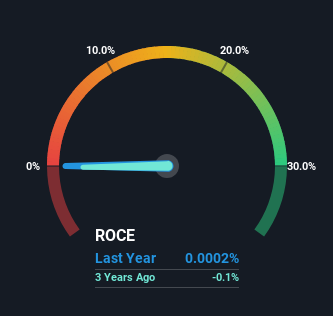- Malaysia
- /
- Construction
- /
- KLSE:ROHAS
Be Wary Of Rohas Tecnic Berhad (KLSE:ROHAS) And Its Returns On Capital

What underlying fundamental trends can indicate that a company might be in decline? A business that's potentially in decline often shows two trends, a return on capital employed (ROCE) that's declining, and a base of capital employed that's also declining. Basically the company is earning less on its investments and it is also reducing its total assets. Having said that, after a brief look, Rohas Tecnic Berhad (KLSE:ROHAS) we aren't filled with optimism, but let's investigate further.
Understanding Return On Capital Employed (ROCE)
For those who don't know, ROCE is a measure of a company's yearly pre-tax profit (its return), relative to the capital employed in the business. The formula for this calculation on Rohas Tecnic Berhad is:
Return on Capital Employed = Earnings Before Interest and Tax (EBIT) ÷ (Total Assets - Current Liabilities)
0.000002 = RM752 ÷ (RM647m - RM240m) (Based on the trailing twelve months to June 2024).
So, Rohas Tecnic Berhad has an ROCE of 0.0002%. Ultimately, that's a low return and it under-performs the Construction industry average of 10.0%.
See our latest analysis for Rohas Tecnic Berhad

While the past is not representative of the future, it can be helpful to know how a company has performed historically, which is why we have this chart above. If you'd like to look at how Rohas Tecnic Berhad has performed in the past in other metrics, you can view this free graph of Rohas Tecnic Berhad's past earnings, revenue and cash flow.
So How Is Rohas Tecnic Berhad's ROCE Trending?
We are a bit worried about the trend of returns on capital at Rohas Tecnic Berhad. About five years ago, returns on capital were 8.1%, however they're now substantially lower than that as we saw above. Meanwhile, capital employed in the business has stayed roughly the flat over the period. This combination can be indicative of a mature business that still has areas to deploy capital, but the returns received aren't as high due potentially to new competition or smaller margins. So because these trends aren't typically conducive to creating a multi-bagger, we wouldn't hold our breath on Rohas Tecnic Berhad becoming one if things continue as they have.
On a side note, Rohas Tecnic Berhad has done well to pay down its current liabilities to 37% of total assets. That could partly explain why the ROCE has dropped. What's more, this can reduce some aspects of risk to the business because now the company's suppliers or short-term creditors are funding less of its operations. Since the business is basically funding more of its operations with it's own money, you could argue this has made the business less efficient at generating ROCE.
Our Take On Rohas Tecnic Berhad's ROCE
All in all, the lower returns from the same amount of capital employed aren't exactly signs of a compounding machine. Investors haven't taken kindly to these developments, since the stock has declined 54% from where it was five years ago. That being the case, unless the underlying trends revert to a more positive trajectory, we'd consider looking elsewhere.
If you want to know some of the risks facing Rohas Tecnic Berhad we've found 2 warning signs (1 can't be ignored!) that you should be aware of before investing here.
For those who like to invest in solid companies, check out this free list of companies with solid balance sheets and high returns on equity.
New: AI Stock Screener & Alerts
Our new AI Stock Screener scans the market every day to uncover opportunities.
• Dividend Powerhouses (3%+ Yield)
• Undervalued Small Caps with Insider Buying
• High growth Tech and AI Companies
Or build your own from over 50 metrics.
Have feedback on this article? Concerned about the content? Get in touch with us directly. Alternatively, email editorial-team (at) simplywallst.com.
This article by Simply Wall St is general in nature. We provide commentary based on historical data and analyst forecasts only using an unbiased methodology and our articles are not intended to be financial advice. It does not constitute a recommendation to buy or sell any stock, and does not take account of your objectives, or your financial situation. We aim to bring you long-term focused analysis driven by fundamental data. Note that our analysis may not factor in the latest price-sensitive company announcements or qualitative material. Simply Wall St has no position in any stocks mentioned.
About KLSE:ROHAS
Rohas Tecnic Berhad
An investment holding company, manufactures steel lattice towers and monopoles for power transmission and telecommunications in Malaysia, Bangladesh, Cambodia, and Nepal.
Adequate balance sheet and slightly overvalued.
Market Insights
Community Narratives





